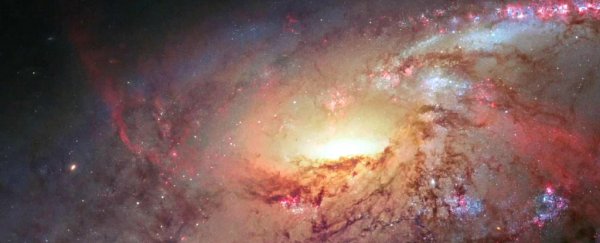A controversial new hypothesis that suggests our understanding of gravity is wrong has just passed an important first test.
First proposed back in 2010, the new hypothesis states that gravity might behave and arise very differently than Einstein predicted, and an independent study of more than 30,000 galaxies has now found the first evidence to back this up.
The hypothesis is referred to as 'Verlinde's hypothesis of gravity' after the theoretical physicist who came up with it, Erik Verlinde from the University of Amsterdam. If it can stand up to further testing, it could completely overhaul over a century of physics - including getting rid of dark matter altogether.
It could even be part of the puzzle that takes us one step closer to one of modern physics' Holy Grails - a much-longed-for 'theory of everything', that merges the observable effects of classic physics, with the weird, microscopic world of quantum mechanics.
The problem with our current understanding of gravity - even though it's widely accepted by the physics community - is that it doesn't quite account for everything we see in the Universe.
Most glaringly, researchers have shown that there's more gravity in our Universe - especially in our galaxies - than can be produced by all the visible matter out there.
This inconsistency has been explained by assuming the presence of dark matter - a mysterious force in the Universe that we can't see that's forming all of this extra gravity. But despite decades of searching and many leading candidates for a dark matter particle, researchers are still no closer to actually detecting this invisible substance.
Verlinde's approach, on the other hand, says we don't need dark matter at all, we just need to rethink gravity.
As we described back in November:
"His suggestion is that gravity isn't a fundamental force of nature at all, but rather an emergent phenomenon - just like temperature is an emergent phenomenon that arises from the movement of microscopic particles.
In other words, gravity is a side effect, not the cause, of what's happening in the Universe."
For the past six years, this hypothesis has been left untested. But now a team of researchers at Leiden University in the Netherlands has tested it for the first time, and shown some evidence that it could actually hold up.
The team, led by Margot Brouwer, looked at the distribution of matter in more than 33,000 galaxies, and said that what they say could indeed be explained without dark matter if they used Verlinde's hypothesis of gravity.
Testing this involved studying something called gravitational lensing - the way galaxies closer to us bend the light of more distant galaxies. This is a well-established way of measuring the amount of dark matter in galaxies.
But the team found that if they just factored in Verlinde's modified gravity, then their results made sense without them having to add in the idea of dark matter.
The team compared their results to the predictions made by Einstein's general theory of relativity and those made by Verlinde, and found that both fit.
But they found that Verlinde's predictions matched their observations without needing to use any free parameters - which are values that can be tweaked to make observations match a hypothesis. The presence of dark matter, on the other hand, required four free parameters.
"The dark matter model actually fits slightly better with the data than Verlinde's prediction," Brouwer told New Scientist. "But then if you mathematically factor in the fact that Verlinde's prediction doesn't have any free parameters, whereas the dark matter prediction does, then you find Verlinde's model is actually performing slightly better."
Importantly, this is just one very early test of Verlinde's hypothesis, and it's going to take a lot more than that to throw out over a century of accepted thinking on gravity and dark matter.
Also, Verlinde's hypothesis might get rid of mysterious dark matter, but it doesn't match up with everything else we see in the Universe, either. String theorist Lubos Motl recently took down Verlinde's ideas a blog post, saying: "I wouldn't okay this wrong piece of work as an undergraduate term paper."
So, to be very clear, our current understanding of gravity, based on Einstein's generally theory of relativity, isn't going anywhere anytime soon. But neither is Verlinde's hypothesis.
"The question now is how the theory develops, and how it can be further tested," said Brouwer in a press release. "But the result of this first test definitely looks interesting."
The research has been accepted for publication in Monthly Notices of the Royal Astronomical Society and you can read the full paper now on arXiv.org.
